Microsurfacing Pavement Solutions with Alternative Aggregates and Binders: A Full Surface Texture Characterization
Abstract
:1. Introduction
2. Materials and Methods
2.1. Materials
2.2. Methods
2.3. Surface Texture Indicators
2.3.1. Statistical Analysis of Profile Heights
- Rpk, which corresponds to the fraction of the profile with the highest peaks and might be linked to the part of the profile that will stick to the tire and be polished under traffic during the pavement service life;
- Rk, which is the contact area region and represents the core of the surface effectively subjected to the traffic loads;
- Rvk, which represents the percentage of the profile with the deepest valleys and is perhaps related to the ability of the surface to evacuate or store water [58].
2.3.2. Intrinsic Indicators by Profile Post-Processing
3. Results and Discussions
3.1. Texture Profiles
3.2. Normality Test
3.3. Abbott-Firestone Curve
3.4. Intrinsic Aggregate Indicators
3.5. Texture Level Spectrum
4. Conclusions
- Microsurfacing is confirmed to be a preventative maintenance solution that can restore the pavement surface, providing good texture properties;
- The texture parameters, traditional or statistical, are dependent on the type/size of aggregates and type/proportion of the binder used; similarly, it is noted that the samples’ manufacturing and profile’s survey directionality could also impact them;
- Based on the adopted mix design, the use of crumb rubber as an aggregate, even at a smaller nominal size, did not present relevant differences in terms of the texture indicator when compared to the other mixtures with the same granulometric distribution;
- The use of AEA has been shown to have an influence on the texture indicators, probably due to its size, 10 mm, but also due to its shape;
- The authors believe that it is necessary to reproduce these tests with a more diverse sample scenario, using different binders and aggregates, while also including information on skid resistance.
Author Contributions
Funding
Institutional Review Board Statement
Informed Consent Statement
Data Availability Statement
Conflicts of Interest
References
- Sandberg, U.; Ejsmont, J.A. Tyre/Road Noise Reference Book, 1st ed.; INFORMEX Ejsmont & Sandberg Handelsbolag: Kisa, Sweden, 2002; ISBN 91-613-2610-9. [Google Scholar]
- Vieira, T.; Sandberg, U.; Erlingsson, S. Negative texture, positive for the environment: Effects of horizontal grinding of asphalt pavements. Road Mater. Pavement Des. 2019, 22, 1–22. [Google Scholar] [CrossRef] [Green Version]
- Praticò, F.G.; Vaiana, R.; Fedele, R. A study on the dependence of PEMs acoustic properties on incidence angle. Int. J. Pavement Eng. 2015, 16, 632–645. [Google Scholar] [CrossRef]
- Christory, J.; Miet, D.; Barre, E.; Sicard, D.; Mahut, B.; Piau, J.; Luminari, M.; Beeldens, A.; Kalman, B. New Road Construction Concepts. Towards Reliable, Green, Safe & Smart and Human Infrastructure in Europe. FEHRL Sixth Framew. Program 2008, 12–13. Available online: https://docplayer.net/10203534-Nr2c-new-road-construction-concepts.html (accessed on 1 December 2022).
- Davies, B.R.; Cenek, D.P.; Henderson, J.R. The Effect of Skid Resistance and Texture on Crash Risk. Christchurch, New Zealand. 2005, 17P (SESSION 6). Available online: https://saferroadsconference.com/wp-content/uploads/2016/05/Peter-Cenek-Effect-Skid-Resistance-Texture-Crash-Risk.pdf (accessed on 1 December 2022).
- Tataranni, P.; Sangiorgi, C. Synthetic aggregates for the production of innovative low impact porous layers for urban pavements. Infrastructures 2019, 4, 48. [Google Scholar] [CrossRef] [Green Version]
- Kousis, I.; Fabiani, C.; Pisello, A.L. A study on the thermo-optical behaviour of phosphorescent coatings for passive cooling applications. E3S Web Conf. 2021, 238, 06002. [Google Scholar] [CrossRef]
- Kousis, I.; Pisello, A.L. For the mitigation of urban heat island and urban noise island: Two simultaneous sides of urban discomfort. Environ. Res. Lett. 2020, 15, 103004. [Google Scholar] [CrossRef]
- Wambold, J.C.; Henry, J.J. International PIARC experiment to compare and harmonize texture and skid resistance measurements. Nord. Road Transp. Res. 1995, 14, 8263–8268. [Google Scholar] [CrossRef] [Green Version]
- Copetti Callai, S.; Sangiorgi, C. A review on acoustic and skid resistance solutions for road pavements. Infrastructures 2021, 6, 41. [Google Scholar] [CrossRef]
- Heitzman, M.; Turner, P.; Greer, M. High Friction Surface Treatment Alternative Aggregates Study; Auburn University: Auburn, AL, USA, 2015. [Google Scholar]
- Kogbara, R.B.; Masad, E.A.; Woodward, D.; Millar, P. Relating surface texture parameters from close range photogrammetry to Grip-Tester pavement friction measurements. Constr. Build. Mater. 2018, 166, 227–240. [Google Scholar] [CrossRef]
- Praticò, F.G.; Vaiana, R.; Iuele, T. Acoustic absorption and surface texture: An experimental investigation. Noise Control Qual. Life 2013, 4, 2901–2909. [Google Scholar] [CrossRef]
- Praticò, F.G.; Anfosso-Lédée, F. Trends and Issues in Mitigating Traffic Noise through Quiet Pavements. Procedia-Soc. Behav. Sci. 2012, 53, 203–212. [Google Scholar] [CrossRef]
- Knabben, R.M.; Trichês, G.; Gerges, S.N.Y.; Vergara, E.F. Evaluation of sound absorption capacity of asphalt mixtures. Appl. Acoust. 2016, 114, 266–274. [Google Scholar] [CrossRef]
- Ahammed, M.A.L.T. Pavement Surface Mixture, Texture and Skid Resistance: A Factorial Analysis. ASCE-Airf. Highw. Pavements 2008, 11, 370–384. [Google Scholar]
- Woodward, D.; Friel, S. Predicting the wear of high friction surfacing aggregate. Coatings 2017, 7, 71. [Google Scholar] [CrossRef] [Green Version]
- Vaiana, R.; Praticò, F. Pavement surface properties and their impact on performance-related pay adjustments. In Proceedings of the 3rd International Conference on Transportation Infrastructure, Pisa, Italy, 22–25 April 2014. [Google Scholar]
- Kuchiishi, K.; Vieira, T.; Copetti Callai, S.; Bernucci, L.L.B. Estudo da macrotextura do pavimento a partir de ensaios de mancha de areia e drenabilidade em conjunto com análise da superfície por estereoscopia. In Proceedings of the XXVIII Anpet-Congresso de Pesquisa e Ensino em Transportes, Curitiba, Brasil, 24–28 November 2014. [Google Scholar]
- ISO 13473-3:2002; ISO Characterization of Pavement Texture by Use of Surface Profiles—Part 3: Specification and Classification of Profilometers. ISO: Geneva, Switzerland, 2002.
- ISO 13473-1:1997; ISO Characterization of Pavement Texture by Use of Surface Profiles—Part 1: Determination of Mean Profile Depth. ISO: Geneva, Switzerland, 1997.
- Praticò, F.G.; Vaiana, R. A study on the relationship between mean texture depth and mean profile depth of asphalt pavements. Constr. Build. Mater. 2015, 101, 72–79. [Google Scholar] [CrossRef]
- Edmondson, V.; Woodward, J.; Lim, M.; Kane, M.; Martin, J.; Shyha, I. Improved non-contact 3D field and processing tech-niques to achieve macrotexture characterisation of pavements. Constr. Build. Mater. 2019, 227, 116693. [Google Scholar] [CrossRef]
- Puzzo, L.; Loprencipe, G.; Tozzo, C.; D’Andrea, A. Three-dimensional survey method of pavement texture using photo-graphic equipment. Meas. J. Int. Meas. Confed. 2017, 111, 146–157. [Google Scholar] [CrossRef]
- Woodham, R.J. Photometric Method For Determining Surface Orientation From Multiple Images. Opt. Eng. 1980, 19, 191139. [Google Scholar] [CrossRef]
- Abdel-Aal, H.A. Functional surfaces for tribological applications: Inspiration and design. Surf. Topogr. Metrol. Prop. 2016, 4, 43001. [Google Scholar] [CrossRef]
- Franco, L.A.; Sinatora, A. 3D surface parameters (ISO 25178-2): Actual meaning of Spk and its relationship to Vmp. Precis. Eng. 2015, 40, 106–111. [Google Scholar] [CrossRef]
- Stoeterau, R.L.; Sinatora, A.; Tertuliano, I.; Pavesi, C.; Fruchtengarten, F.; Ono, F.S. Study of Dimple Texturized Surfaces Op-erating without Lubrication. In Proceedings of the 23rd SAE Brasil International Congress and Display, Sao Paulo, Brazil, 30 September–2 October 2014; SAE International: Warrendale, PA, USA, 2014. [Google Scholar]
- Praticò, F.G.; Vaiana, R. Permeable friction courses: Area-based vs. Line-based surface performance and indicators. Noise Control Qual. Life 2013, 1, 117–126. [Google Scholar]
- Grilli, A.; Graziani, A.; Carter, A.; Sangiorgi, C.; Pivoto Specht, L.; Copetti Callai, S. Slurry surfacing: A review of definitions, descriptions and current practices. RILEM Tech. Lett. 2019, 4, 103–109. [Google Scholar] [CrossRef]
- Li, S.; Xiong, R.; Yu, D.; Zhao, G.; Cong, P.; Jiang, Y. Friction Surface Treatment Selection: Aggregate Properties, Surface Characteristics, Alternative Treatments, and Safety Effects; Purdue University: West Lafayette, IN, USA, 2017; ISBN 9781622604784. [Google Scholar]
- De Larrard, F.; Martinez-Castillo, R.; Sedran, T.; Hauza, P.; Poirier, J.E. Cementitious artificial aggregate particles for high-skid resistance pavements. Road Mater. Pavement Des. 2012, 13, 376–384. [Google Scholar] [CrossRef]
- Bennert, T.; Hanson, D.; Maher, A.; Vitillo, N. Influence of Pavement Surface Type on Tire/Pavement Generated Noise. J. Test. Eval. 2005, 22, 98–103. [Google Scholar] [CrossRef] [Green Version]
- Sangiorgi, C.; Bitelli, G.; Lantieri, C.; Irali, F.; Girardi, F. A Study on Texture and Acoustic Properties of Cold Laid Micro-surfacings. Procedia-Soc. Behav. Sci. 2012, 53, 223–234. [Google Scholar] [CrossRef] [Green Version]
- Do, M.T.; Cerezo, V.; Beautru, Y.; Kane, M. Modeling of the connection road surface microtexture/water depth/friction. Wear 2013, 302, 1426–1435. [Google Scholar] [CrossRef]
- Goubert, L. A new test track with the ultra noise reducing Poro-elastic Road Surface (PERS) in Gent, Belgium. In Proceedings of the INTER-NOISE 2019 MADRID-48th International Congress and Exposition on Noise Control Engineering, Madrid, Spain, 16–19 June 2019. [Google Scholar]
- Li, W.; Han, S.; Huang, Q. Performance of noise reduction and skid resistance of durable granular ultra-thin layer asphalt pavement. Materials 2020, 13, 4260. [Google Scholar] [CrossRef]
- Vaiana, R.; Balzano, F.; Iuele, T.; Gallelli, V. Microtexture performance of EAF slags used as aggregate in asphalt mixes: A comparative study with surface properties of natural stones. Appl. Sci. 2019, 9, 3197. [Google Scholar] [CrossRef] [Green Version]
- Callai, S.C.; Tataranni, P.; Sangiorgi, C. Preliminary evaluation of geopolymer mix design applying the design of experiments method. Infrastructures 2021, 6, 35. [Google Scholar] [CrossRef]
- Provis, J.L.; Rees, C. Geopolymers: Structures, Processing, Properties and Industrial Applications; Woodhead: Sawston, UK, 2009. [Google Scholar]
- Makoundou, C.; Johansson, K.; Wallqvist, V.; Sangiorgi, C. Functionalization of crumb rubber surface for the incorporation into asphalt layers of reduced stiffness: An overview of existing treatment approaches. Recycling 2021, 6, 19. [Google Scholar] [CrossRef]
- Makoundou, C.; Sangiorgi, C.; Johansson, K.; Wallqvist, V. Development of functional rubber-based impact-absorbing pavements for cyclist and pedestrian injury reduction. Sustainability 2021, 13, 11283. [Google Scholar] [CrossRef]
- Patrick, S. Guidelines and specifications for microsurfacing. In Austroads Research Report AP-R569-18; Austroads: Sydney, Australia, 2018. [Google Scholar]
- ISSA. 143 Recommended Performance Guidelines for Micro Surfacing, International Slurry Surfacing Association, Annapolis. In ISSA Guideline A143; ISSA: Glen Ellyn, IL, USA, 2010. [Google Scholar]
- ISSA. TB 100 Laboratory Test Method for Wet Track Abrasion of Slurry Surfacing Systems, International Slurry Surfacing Association; ISSA: Glen Ellyn, IL, USA, 2018. [Google Scholar]
- Praticò, F.G.; Vaiana, R. A study on volumetric versus surface properties of wearing courses. Constr. Build. Mater. 2013, 38, 766–775. [Google Scholar] [CrossRef]
- Boscaino, G.; Pratico, F.G. Classification and inventory of indicators of pavement surface texture. Bull. La-Boratoires Ponts Chaussées 2001, 234, 17–34. [Google Scholar]
- Boscaino, G.; Praticò, F.G.; Vaiana, R. Tyre/road noise on different road pavements: Synergetic influence of acoustical absorbing coefficient and surface texture. In Proceedings of the 10th EAEC European Congress, Belgrade, Serbia, 30 May–1 June 2005; Volume 30. [Google Scholar]
- Aavik, A.; Kaal, T.; Jentson, M. Use of Pavement Surface Texture Characteristics Measurement Results in Estonia. In Proceedings of the The XXVIII International Baltic Road Conference, Vilnius, Lithuania, 26–28 August 2013; pp. 1–10. [Google Scholar]
- Ongel, A.; Harvey, J.T.; Kohler, E.; Lu, Q.; Steven, B.D. Investigation of Noise, Durability, Permeability, and Friction Performance Trends for Asphalt Pavement Surface Types: First- and Second-Year Results; University of California Pavement Research Center: Sacramento, CA, USA, 2008. [Google Scholar]
- Ongel, A.; Harvey, J. Pavement characteristics affecting the frequency content of tire/pavement noise. Noise Control Eng. J. 2010, 58, 563–571. [Google Scholar] [CrossRef]
- Vaiana, R.; Praticó, F.G.; Iuele, T.; Gallelli, V.; Minani, V. Effect of asphalt mix properties on surface texture: An experimental study. Appl. Mech. Mater. 2013, 368–370, 1056–1060. [Google Scholar] [CrossRef]
- Zhan, W.; Huang, P. Modeling tangential contact based on non-Gaussian rough surfaces. Proc. Inst. Mech. Eng. Part J J. Eng. Tribol. 2019, 233, 51–60. [Google Scholar] [CrossRef]
- Gabriel, P.; Thomas, A.G.; Busfield, J.J.C. Influence of interface geometry on rubber friction. Wear 2010, 268, 747–750. [Google Scholar] [CrossRef]
- Salcedo, M.C.; Coral, I.B.; Ochoa, G.V. Characterization of surface topography with Abbott Firestone curve. Contemp. Eng. Sci. 2018, 11, 3397–3407. [Google Scholar] [CrossRef]
- Schmähling, J.; Hamprecht, F.A. Generalizing the Abbott-Firestone curve by two new surface descriptors. Wear 2007, 262, 1360–1371. [Google Scholar] [CrossRef]
- Vieira, T. Asphaltic Pavement Surface Analysis and Its Effects on the Tyre-Pavement Friction Performance. Ph.D. Thesis, Universidade de São Paulo, São Paulo, Brazil, 2014. [Google Scholar]
- Ech, M.; Morel, S.; Yotte, S.; Breysse, D.; Pouteau, B. An Original Evaluation of the Wearing Course Macrotexture Evolution using the Abbot Curve. Road Mater. Pavement Des. 2009, 10, 471–494. [Google Scholar] [CrossRef]
- Meegoda, J.N.; Gao, S.; Liu, S.; Gephart, N.C. Pavement texture from high-speed laser for pavement management system. Int. J. Pavement Eng. 2013, 14, 697–705. [Google Scholar] [CrossRef]
- Vaitkus, A.; Andriejauskas, T.; Šernas, O.; Čygas, D.; Laurinavičius, A. Definition of concrete and composite precast concrete pavements texture. Transport 2019, 34, 404–414. [Google Scholar] [CrossRef] [Green Version]
- Do, M.T.; Cerezo, V. Road surface texture and skid resistance. Surf. Topogr. Metrol. Prop. 2015, 3, 043001. [Google Scholar] [CrossRef]
- Edjeou, W.; Cerezo, V.; Zahouani, H.; Salvatore, F. Multiscale analyses of pavement texture during polishing. Surf. Topogr. Metrol. Prop. 2020, 8, 024008. [Google Scholar] [CrossRef]
- ISO 13473-4:2008; Characterization of Pavement Texture by Use of Surface Profiles–Part 4: Spectral Analysis of Texture Profiles. International Organization for Standardization: Geneva, Switzerland, 2008.
- Kovács, Z.F.; Viharos, Z.J.; Kodácsy, J. Determination of the working gap and optimal machining parameters for magnetic assisted ball burnishing. Meas. J. Int. Meas. Confed. 2018, 118, 172–180. [Google Scholar] [CrossRef] [Green Version]
- Krolczyk, G.M.; Krolczyk, J.B.; Maruda, R.W.; Legutko, S.; Tomaszewski, M. Metrological changes in surface morphology of high-strength steels in manufacturing processes. Meas. J. Int. Meas. Confed. 2016, 88, 176–185. [Google Scholar] [CrossRef]
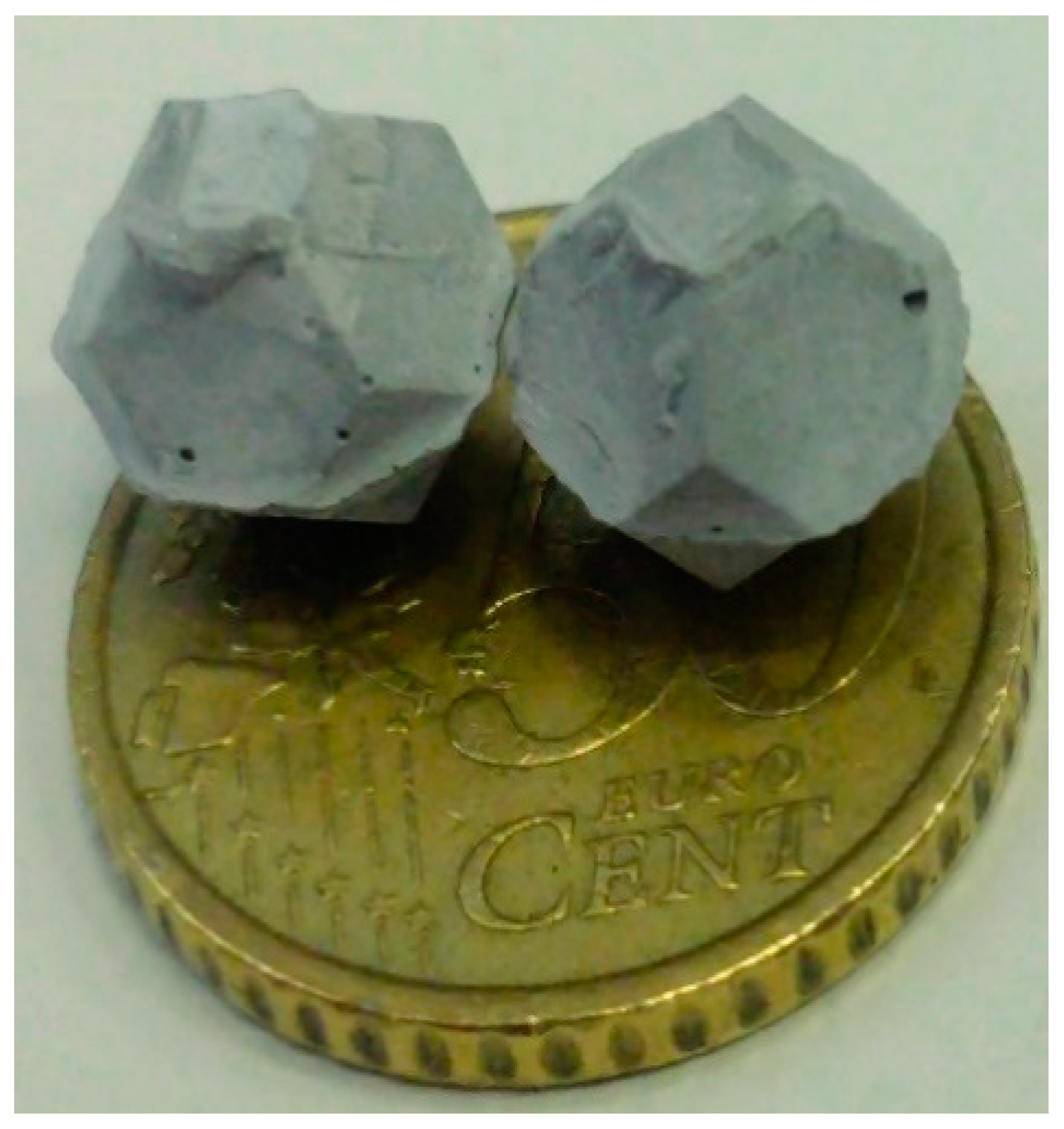

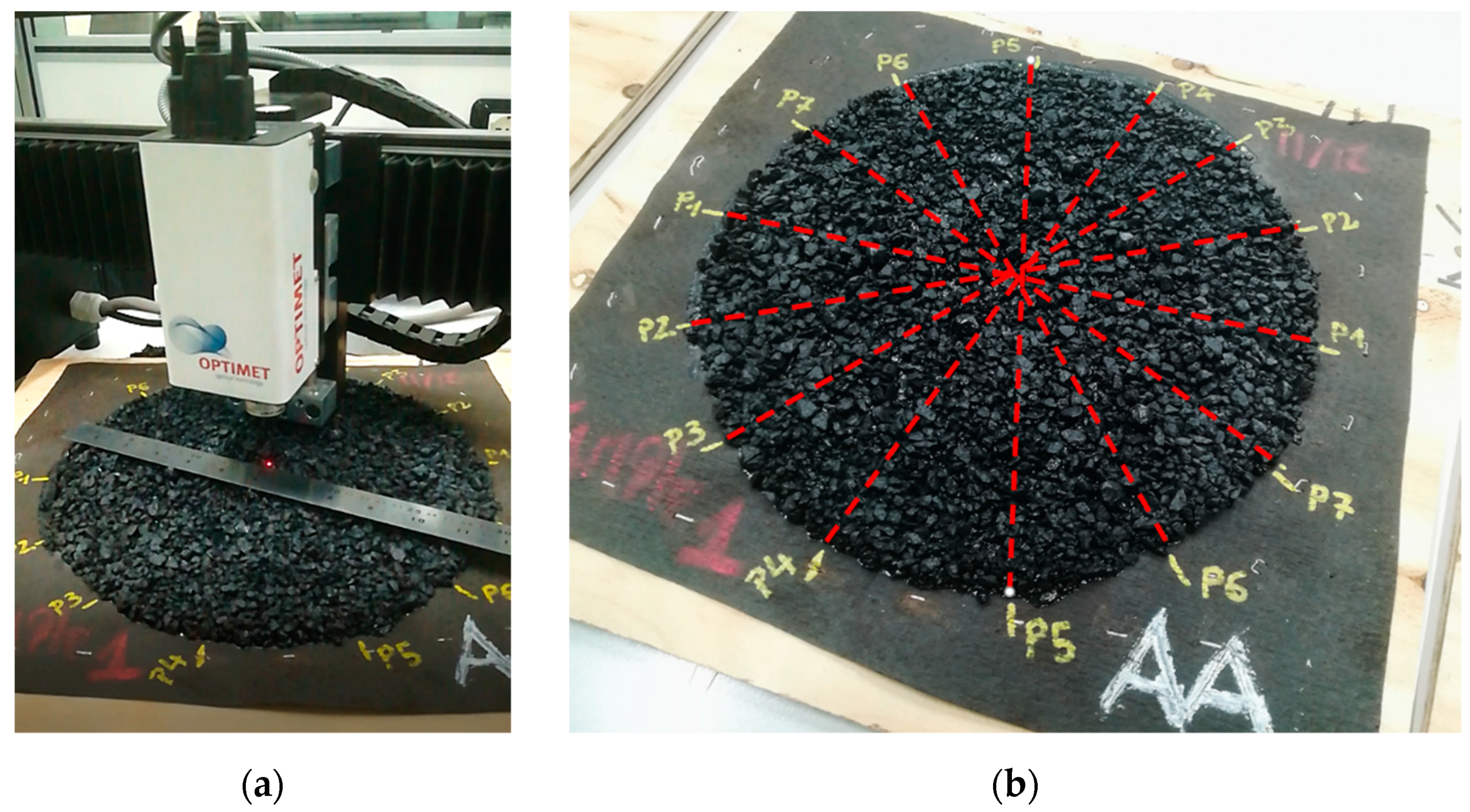
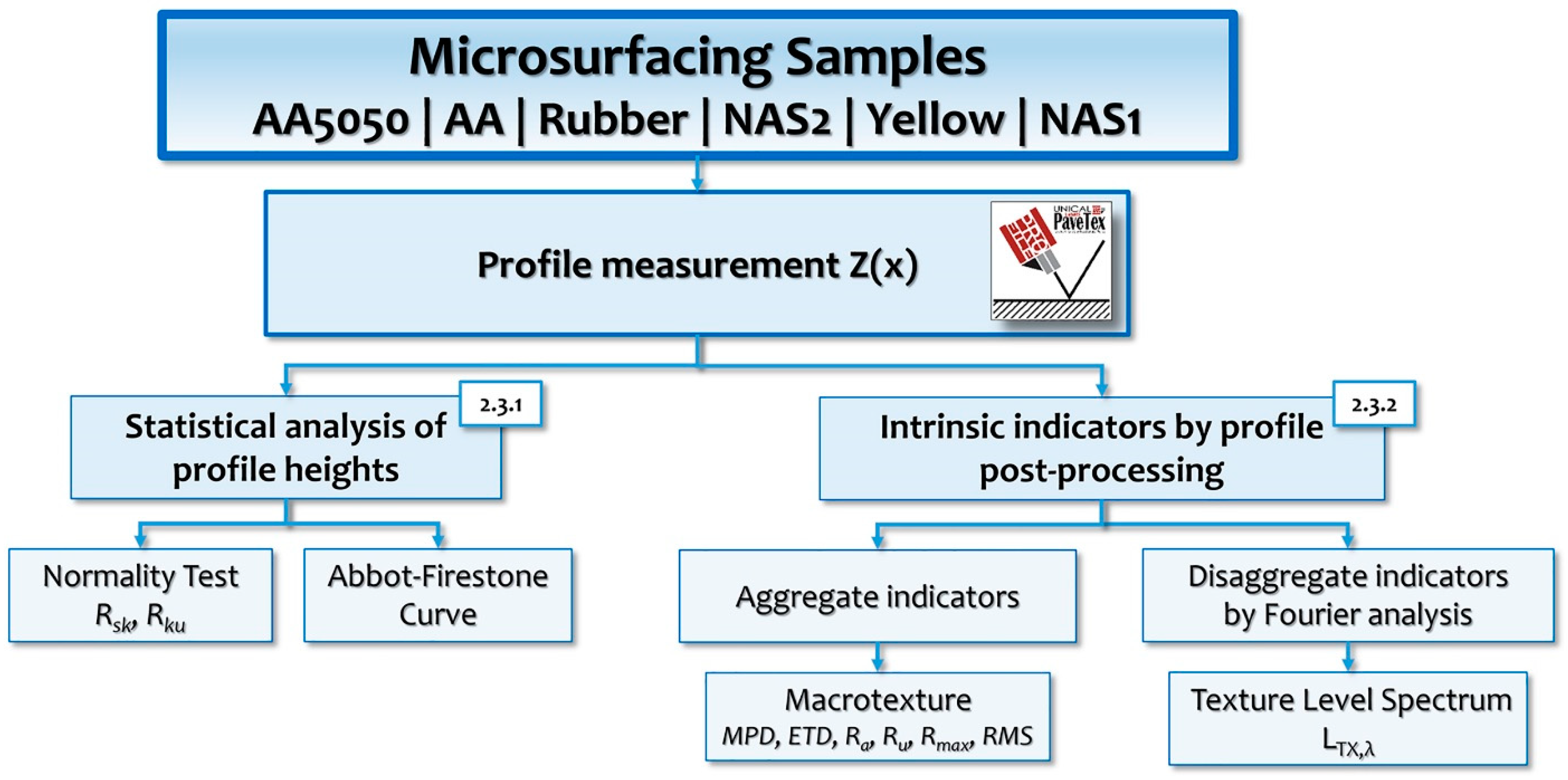
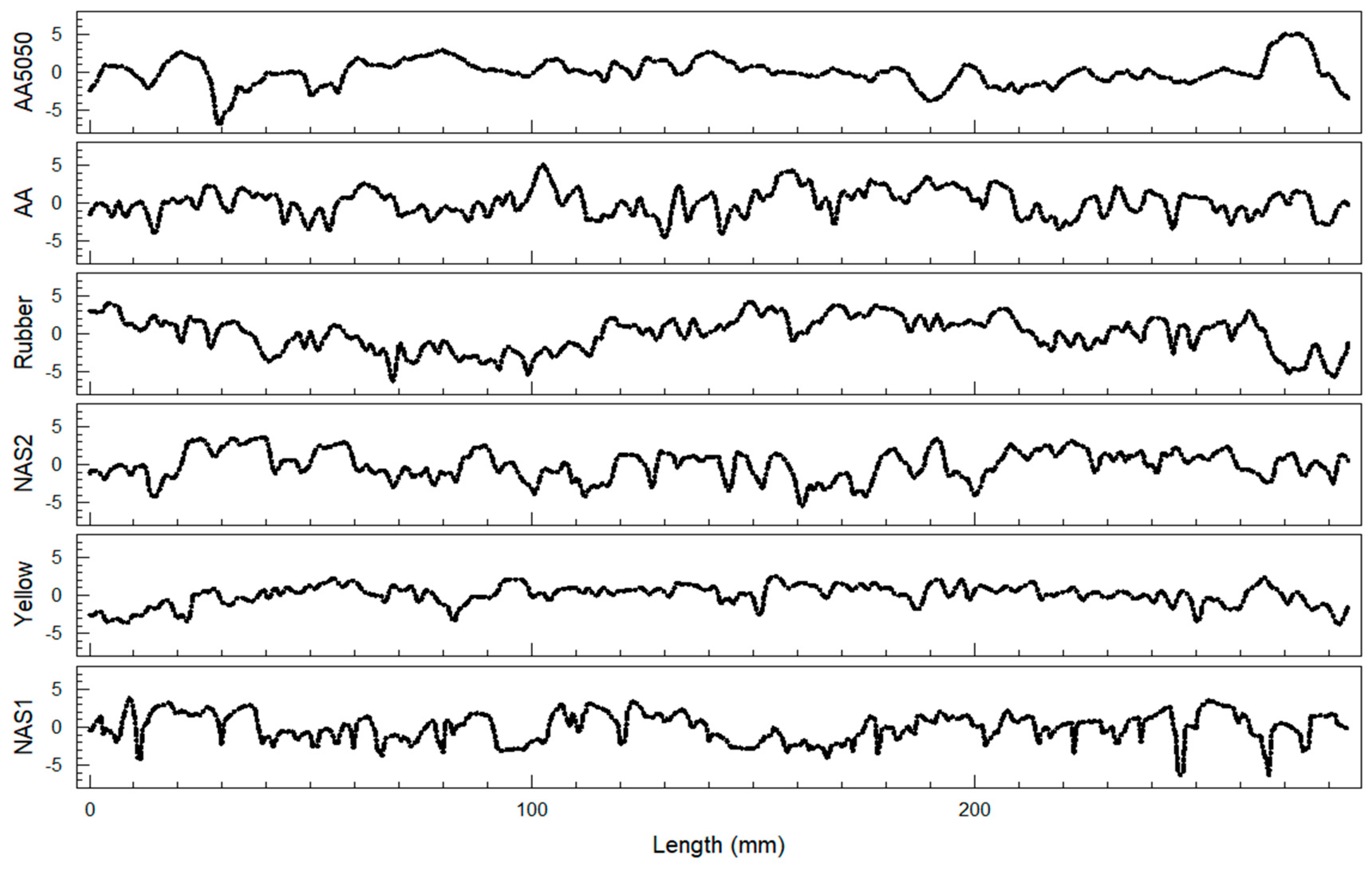

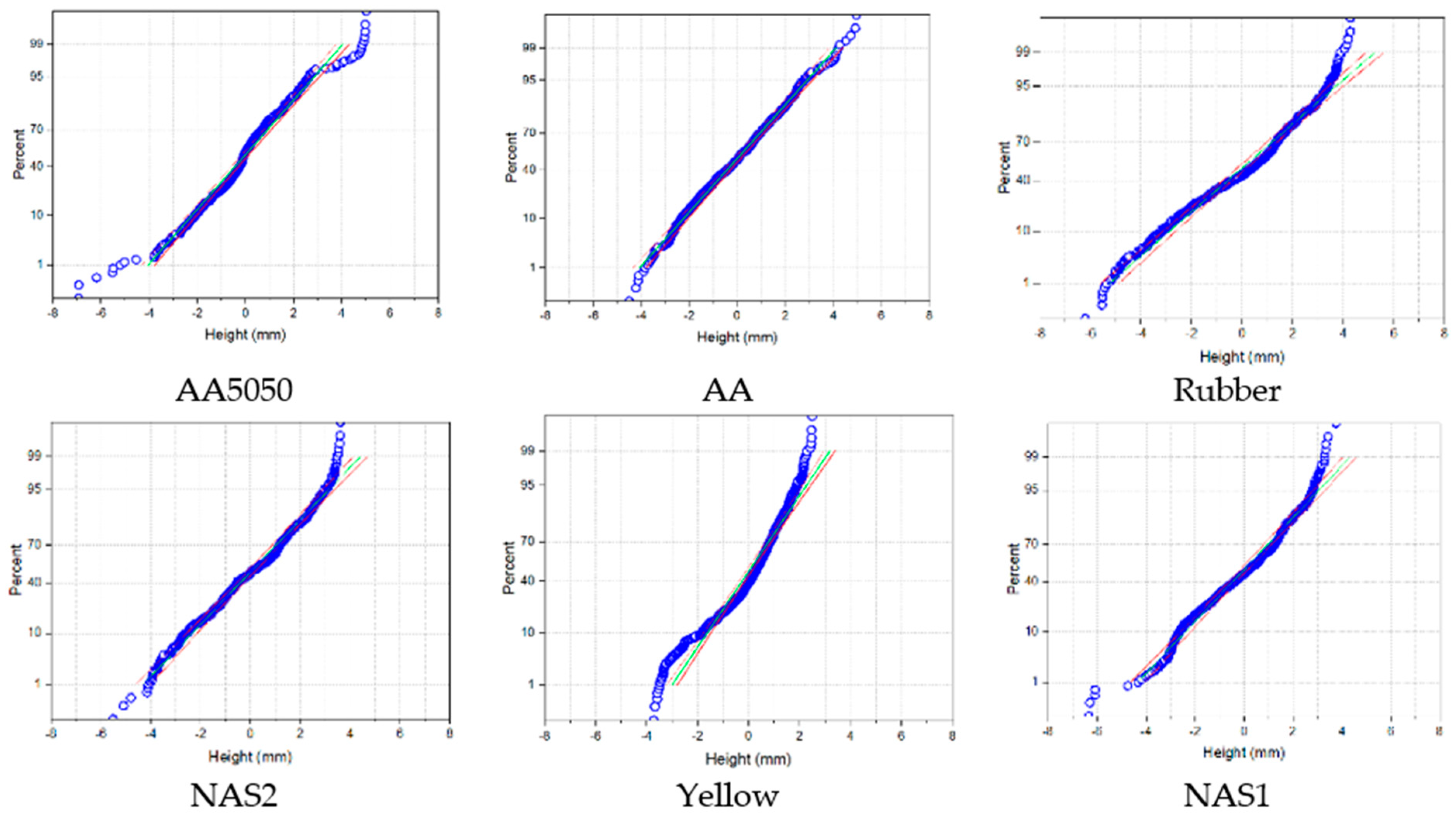
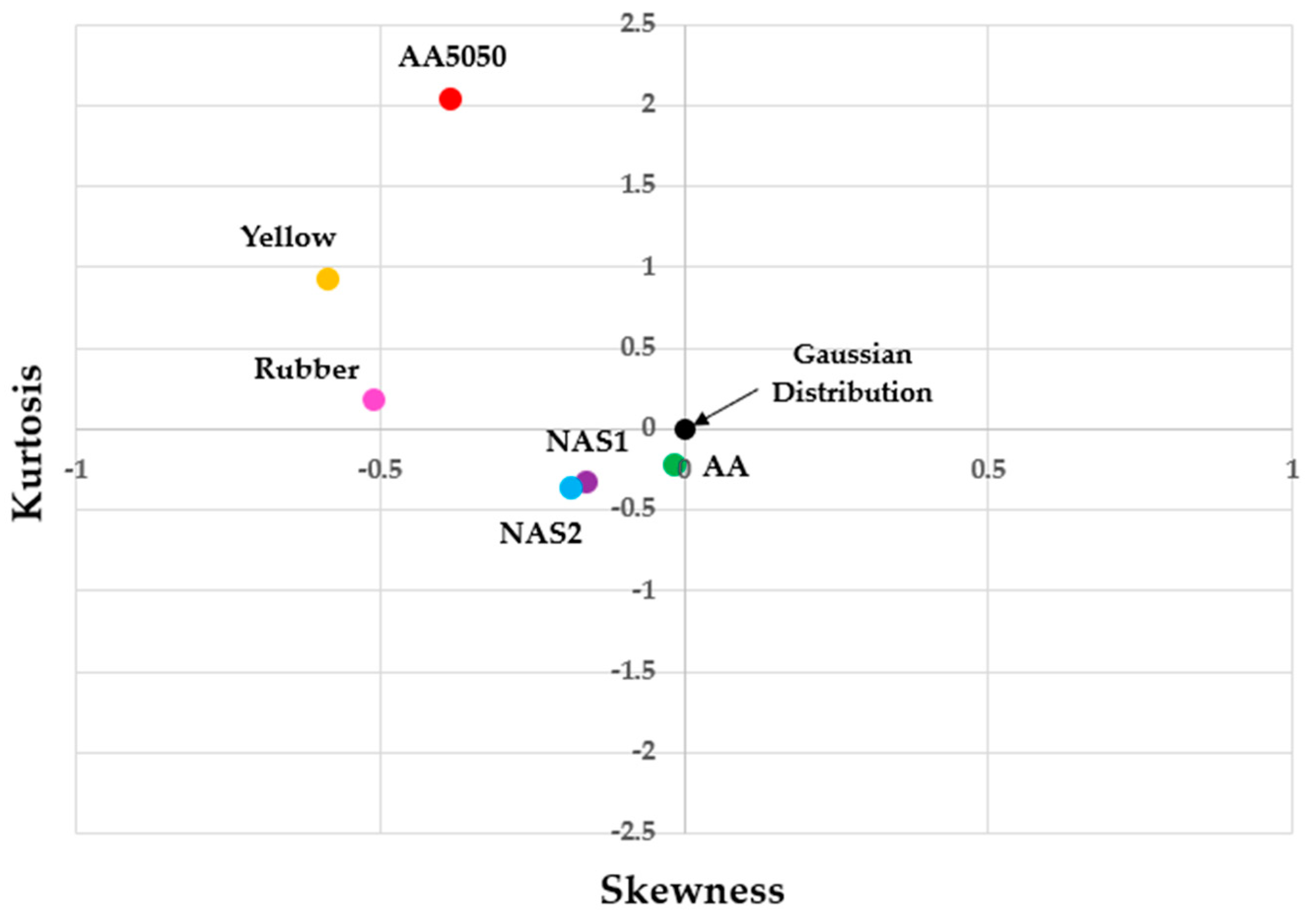


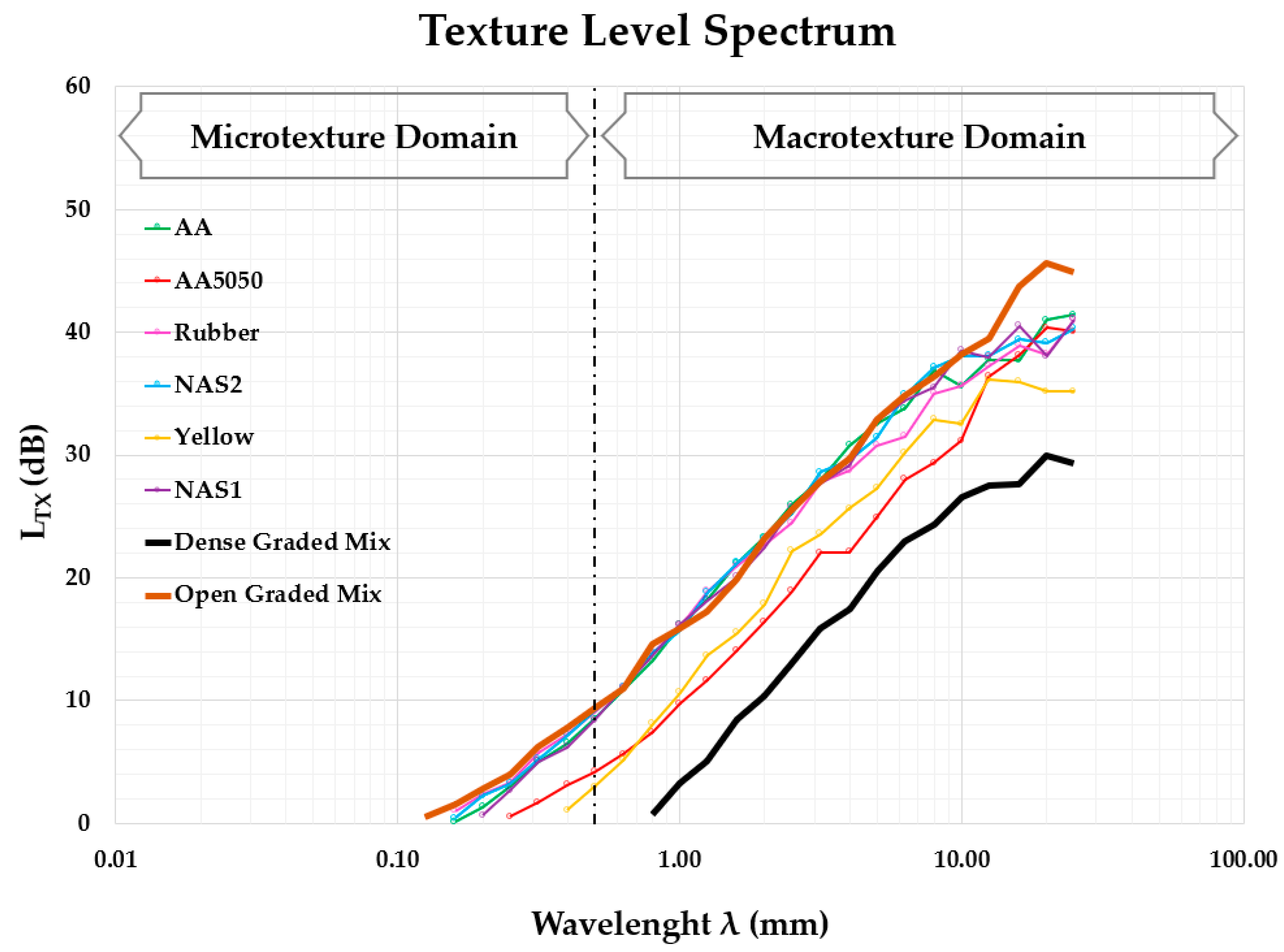
| Properties | Specification | Basaltic Aggregate 0/6 | Basaltic Aggregate 4/8 |
|---|---|---|---|
| Bulk Specific Gravity [Mg/m3] | UNI EN 1097-6 | 2.68 | 2.66 |
| Crushed Particles [%] | UNI EN 933-5 | 100 | 100 |
| Methylene Blue Test | UNI EN 933-9 | 0.8 | - |
| Shape Index [-] | UNI EN 933-4 | - | 15 |
| Flakiness Index [-] | UNI EN 933-3 | - | 10 |
| Micro Deval [-] | UNI EN 1097-1 | - | 10 |
| Los Angeles [%] | UNI EN 1097-2 | - | 20 |
| Polished Stone Value [-] | UNI EN 1097-8 | - | 50 |
| Name | Type of Binder | Type of Aggregate | Granulometric Information |
|---|---|---|---|
| AA5050 | Asphalt emulsion modified with latex | NA AEA | 50% < sieve #2 of 0/6 NA 50% 10 mm single size AEA |
| AA | Asphalt emulsion modified with latex | NA AEA | Australian gradation curve (0/10 mm) replacing 10 mm NA by 10 mm AEA |
| Rubber | Asphalt emulsion modified with latex | NA CR | 40% NA 60% 0/4 mm CR |
| NAS2 | Asphalt emulsion modified with latex | NA | 0/8 mm |
| Yellow | Non-asphaltic resin | NA | 0/6 mm |
| NAS1 | Asphalt emulsion modified with latex | NA | 0/8 mm |
| Indicator | Name | Formula | Graphical Explanation |
|---|---|---|---|
| Rsk | Skewness | 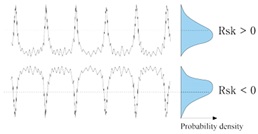 | |
| Rku | Kurtosis | 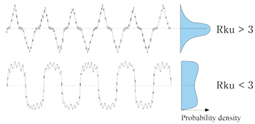 | |
| Probability Density Curve | Bearing curve (Abbot curve) | - | 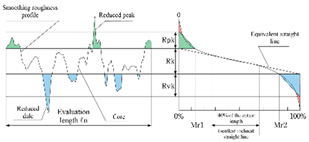 |
| Aggregate Intrinsic Indicators | Name | Formula | Graphical Explanation |
|---|---|---|---|
| MPDiso | Mean Profile Depth [52] |  | |
| MPDaipcr | Mean Profile Depth [8] | - |  |
| ETD1995iso | Estimated Texture Depth [18] | - | |
| ETD2019iso | Estimated Texture Depth [52] | - | |
| Ra | Average Roughness | 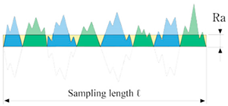 | |
| Ru | Height to the mean | 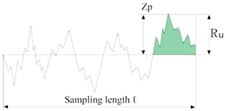 | |
| Rz | Average peak-to-valley height | 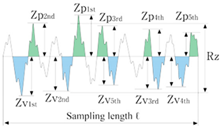 | |
| Rmax (Rt) | Maximum total height | 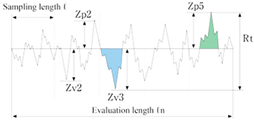 | |
| RMS (Rq) | Root Mean Square | 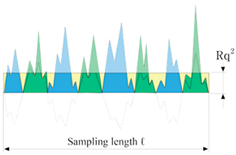 | |
| Spectral Intrinsic Indicators | Name | Formula | Graphical Explanation |
| LTX,λ | Texture Level (for given wavelength λ) | For | - |
| Sample | K-S Test | Descriptive Statistics | |||||
|---|---|---|---|---|---|---|---|
| Statistics | p-Value | Decision at Level (5%) | Mean | Median | Rku | Rsk | |
| AA5050 | 0.05271 | 0.02158 | Reject normal | 0.00258 | 0.08075 | 2.03850 | −0.38128 |
| AA | 0.01551 | 0.02130 | Can’t reject normal | −0.00570 | 0.01032 | −0.22259 | −0.01487 |
| Rubber | 0.04728 | 0.02140 | Reject normal | 0.00242 | 0.17487 | 0.17292 | −0.50802 |
| NAS2 | 0.03569 | 0.02099 | Reject normal | 0.00207 | 0.04557 | −0.37487 | −0.18550 |
| Yellow | 0.04056 | 0.02143 | Reject normal | −0.00081 | 0.06757 | 0.92019 | −0.58339 |
| NAS1 | 0.02559 | 0.02130 | Reject normal | −0.00514 | 0.01069 | −0.33301 | −0.15955 |
| Sample | Mr1 (mm) | Mr2 (mm) | Inclination (%) | Rpk (mm) | Rvk (mm) | Rk (mm) |
|---|---|---|---|---|---|---|
| AA5050 | 2.072 | −1.356 | 4.897 | 2.996 | 5.580 | 3.428 |
| AA | 2.381 | −1.574 | 5.649 | 3.226 | 4.908 | 3.954 |
| Rubber | 2.500 | −1.639 | 5.913 | 1.892 | 3.268 | 7.098 |
| NAS2 | 2.391 | −1.568 | 5.655 | 2.834 | 5.489 | 3.959 |
| Yellow | 1.511 | −0.996 | 3.581 | 1.289 | 4.572 | 2.507 |
| NAS1 | 2.392 | −1.582 | 5.678 | 2.233 | 6.053 | 3.974 |
| Indicator | AA5050 (Avg mm) | AA (Avg mm) | Rubber (Avg mm) | NAS2 (Avg mm) | Yellow (Avg mm) | NAS1 (Avg mm) |
|---|---|---|---|---|---|---|
| MPDiso | 2.255 | 3.587 | 2.631 | 3.054 | 1.971 | 2.930 |
| MPDaipcr | 2.776 | 3.907 | 2.637 | 3.568 | 2.209 | 3.396 |
| ETD1995iso | 2.004 | 3.070 | 2.305 | 2.643 | 1.776 | 2.544 |
| ETD2019iso | 2.481 | 3.946 | 2.894 | 3.360 | 2.168 | 3.223 |
| Ra | 1.011 | 1.499 | 1.393 | 1.440 | 0.835 | 1.411 |
| Ru | 2.564 | 4.035 | 2.994 | 3.584 | 2.318 | 3.505 |
| Rz | 3.427 | 5.696 | 4.463 | 5.414 | 3.082 | 4.617 |
| Rmax | 4.893 | 6.994 | 6.318 | 7.143 | 4.392 | 5.935 |
| RMS | 1.383 | 1.850 | 1.896 | 1.797 | 1.108 | 1.776 |
Publisher’s Note: MDPI stays neutral with regard to jurisdictional claims in published maps and institutional affiliations. |
© 2022 by the authors. Licensee MDPI, Basel, Switzerland. This article is an open access article distributed under the terms and conditions of the Creative Commons Attribution (CC BY) license (https://creativecommons.org/licenses/by/4.0/).
Share and Cite
Callai, S.C.; De Rose, M.; Tataranni, P.; Makoundou, C.; Sangiorgi, C.; Vaiana, R. Microsurfacing Pavement Solutions with Alternative Aggregates and Binders: A Full Surface Texture Characterization. Coatings 2022, 12, 1905. https://doi.org/10.3390/coatings12121905
Callai SC, De Rose M, Tataranni P, Makoundou C, Sangiorgi C, Vaiana R. Microsurfacing Pavement Solutions with Alternative Aggregates and Binders: A Full Surface Texture Characterization. Coatings. 2022; 12(12):1905. https://doi.org/10.3390/coatings12121905
Chicago/Turabian StyleCallai, Sergio Copetti, Manuel De Rose, Piergiorgio Tataranni, Christina Makoundou, Cesare Sangiorgi, and Rosolino Vaiana. 2022. "Microsurfacing Pavement Solutions with Alternative Aggregates and Binders: A Full Surface Texture Characterization" Coatings 12, no. 12: 1905. https://doi.org/10.3390/coatings12121905
APA StyleCallai, S. C., De Rose, M., Tataranni, P., Makoundou, C., Sangiorgi, C., & Vaiana, R. (2022). Microsurfacing Pavement Solutions with Alternative Aggregates and Binders: A Full Surface Texture Characterization. Coatings, 12(12), 1905. https://doi.org/10.3390/coatings12121905











